Scorpions are predatory arthropod animals of the order Scorpiones within the class
Arachnida. They have eight legs and are easily recognized by the pair of grasping claws and the narrow, segmented tail, often carried in a characteristic forward curve over the back, ending with a venomous stinger. Scorpions range in size from 9 mm (Typhlochactas mitchelli) to 21 cm
(Hadogenes troglodytes).
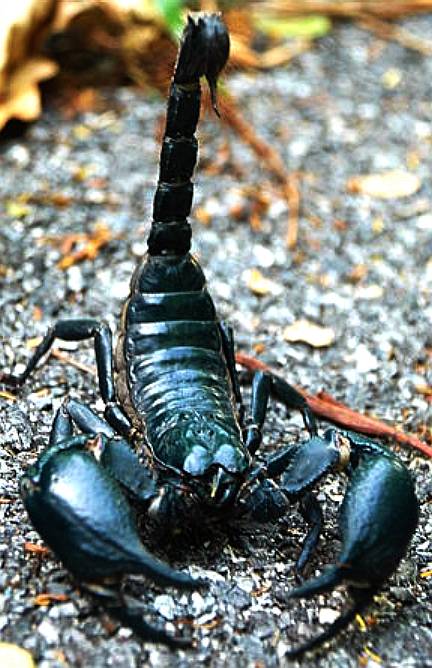
Scorpions are found widely distributed over all continents, except
Antarctica, in a variety of terrestrial habitats except the high latitude tundra. Scorpions number about 1,752 described
species, with 13 extant families recognised to date. The taxonomy has undergone changes and is likely to change further, as a number of genetic studies are bringing forth new information.
Scorpion venom has a fearsome reputation, and about 25 species are known to have venom capable of killing a
human being.
Arachnid
Etymology
The word scorpion is thought to have originated in Middle English between 1175 and 1225 AD from Old French skorpiō, or from Italian scorpione, both derived from the Latin word
scorpius, which in turn has its roots in the Greek word σκορπίος – skorpíos.
Geographical distribution
Scorpions are found on all major land masses except Antarctica. Scorpions did not occur naturally in Great Britain,
New Zealand and some of the islands in Oceania, but have now been accidentally introduced in some of these places by human trade and
commerce. The greatest diversity of scorpions in the Northern Hemisphere is to be found in the subtropical areas lying between latitudes 23° N and 38° N. Above these latitudes, the diversity decreases, with the northernmost occurrence of scorpions being the northern scorpion Paruroctonus boreus at 50°
N.
Today, scorpions are found in virtually every terrestrial habitat, including high-elevation mountains, caves and intertidal zones, with the exception of boreal ecosystems, such as the tundra, high-altitude taiga and the permanently snow-clad tops of some
mountains. As regards microhabitats, scorpions may be ground-dwelling, tree-living, lithophilic (rock-loving) or psammophilic (sand-loving); some species, such as Vaejovis janssi, are versatile and found in every type of habitat in Baja
California, while others occupy specialised niches such as Euscorpius carpathicus, which occupies the littoral zone of the
shore.
Five colonies of scorpions (Euscorpius flavicaudis) have established themselves in Sheerness on the Isle of Sheppey in the
United
Kingdom. This small population has been resident since the 1860s, having probably arrived with imported fruit from Africa. This scorpion species is small and completely harmless to humans. This marks the northernmost limit where scorpions live in the
wild.
Classification
- Taxonomy
There are thirteen families and about 1,400 described species and subspecies of scorpions. In addition, there are 111 described taxa of extinct
scorpions.
This classification is based on that of Soleglad & Fet
(2003), which replaced the older, unpublished classification of
Stockwell. Additional taxonomic changes are from papers by Soleglad et
al (2005).
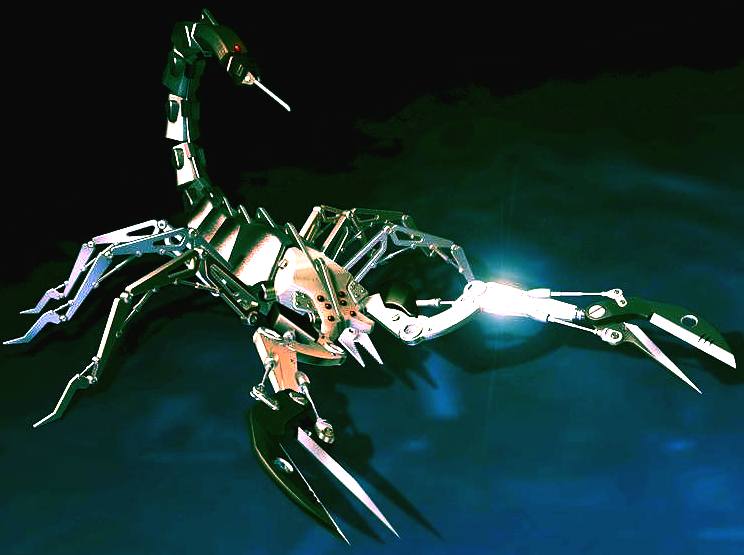
Systematics
The following classification covers extant taxa to the rank of family.
Order Scorpiones
Infraorder Orthosterni Pocock, 1911
Parvorder Pseudochactida Soleglad et Fet, 2003
Superfamily Pseudochactoidea Gromov, 1998
Family Pseudochactidae Gromov, 1998
Parvorder Buthida Soleglad et Fet, 2003
Superfamily Buthoidea C. L. Koch, 1837
Family Buthidae C. L. Koch, 1837 (thick-tailed scorpions)
Family Microcharmidae Lourenço, 1996
Parvorder Chaerilida Soleglad et Fet, 2003
Superfamily Chaeriloidea Pocock, 1893
Family Chaerilidae Pocock, 1893
Parvorder Iurida Soleglad et Fet, 2003
Superfamily Chactoidea Pocock, 1893
Family Chactidae Pocock, 1893
Family Euscorpiidae Laurie, 1896
Family Superstitioniidae Stahnke, 1940
Family Vaejovidae Thorell, 1876
Superfamily Iuroidea Thorell, 1876
Family Caraboctonidae Kraepelin, 1905 (hairy scorpions)
Family Iuridae Thorell, 1876
Superfamily Scorpionoidea Latreille, 1802
Family Bothriuridae Simon, 1880
Family Hemiscorpiidae Pocock, 1893 (= Ischnuridae, =Liochelidae) (rock scorpions, creeping scorpions, or tree scorpions)
Family Scorpionidae Latreille, 1802 (burrowing scorpions or pale-legged scorpions)
Scorpions
on Youtube
FOSSIL
RECORD
Scorpions have been found in many fossil records, including marine Silurian deposits, coal deposits from the Carboniferous Period and in amber. The oldest known scorpions lived around 430 million years ago in the Silurian period, on the bottom of shallow tropical
seas. These first scorpions had gills instead of the present forms' book lungs. Currently, 111 fossil species of scorpion are
known.
Unusually for arachnids, there are more species of Palaeozoic scorpion than Mesozoic or Cenozoic ones.
The eurypterids, marine creatures that lived during the Paleozoic era, share several physical traits with scorpions and may be closely related to them. Various species of Eurypterida could grow to be anywhere from 10 centimetres (3.9 in) to 2.5 metres (8.2 ft) in
length. However, they exhibit anatomical differences marking them off as a group distinct from their Carboniferous and Recent relatives. Despite this, they are commonly referred to as "sea
scorpions". Their legs are thought to have been short, thick, tapering and to have ended in a single strong claw; it appears that they were well-adapted for maintaining a secure hold upon rocks or seaweed against the wash of waves, like the legs of a shore crab.
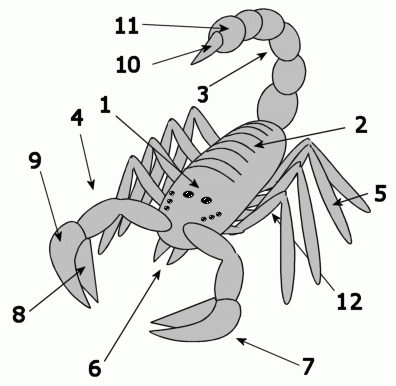
ANATOMY
The body of a scorpion is divided into three parts (tagmata): the head (cephalothorax), the abdomen (mesosoma) and the tail
(metasoma).
Scorpion
anatomy:
1 = Cephalothorax or Prosoma;
2 = Abdomen or Mesosoma;
3 = Tail or Metasoma;
4 = Claws or Pedipalps
5 = Legs;
6 = Mouth parts or Chelicerae;
7 = pincers or Chelae;
8 = Moveable claw or Tarsus;
9 = Fixed claw or Manus;
10 = Sting or Telson;
11 = Anus.
Cephalothorax
The cephalothorax, also called the prosoma, comprises the carapace, eyes, chelicerae (mouth parts), pedipalps (the pedipalps of scorpions have chelae, commonly called claws or pincers) and four pairs of walking legs. The scorpion's exoskeleton is thick and durable, providing good protection from predators. Scorpions have two eyes on the top of the cephalothorax, and usually two to five pairs of eyes along the front corners of the cephalothorax. The position of the eyes on the cephalothorax depends in part on the hardness or softness of the soil upon which they spend their
lives.
The pedipalp is a segmented, chelate (clawed) appendage used for prey immobilization, defense, and sensory purposes. The segments of the pedipalp (from closest to the body outwards) are coxa, trochanter, femur (humerus), patella, tibia (including the fixed claw and the manus) and tarsus (moveable
claw). A scorpion has darkened or granular raised linear ridges, called "keels" or carinae on the pedipalp segments and on other parts of the body, which are useful
taxonomically.
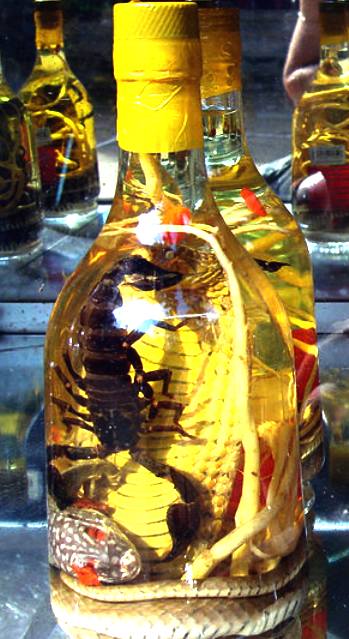
Mesosoma
The abdomen, also called the opisthosoma, consists of seven segments (somites), each covered dorsally by a sclerotosed plate (tergum) and also ventrally for segments 3 to 7. The first abdominal segment bears a pair of genital opercula covering the gonopore. Segment 2 consists of the basal plate with the pectines. Each of the mesosomal segments 3 to 7 have a pair of spiracles, the openings for the scorpion's respiratory organs, known as book lungs. The spiracle openings may be slits, circular, elliptical, or
oval.
Metasoma
The metasoma, the scorpion's tail, comprises five caudal segments (the first tail segment looks like a last mesosoman segment), and sixth bearing the telson (the sting). The telson, in turn, consists of the vesicle, which holds a pair of venom glands, and the hypodermic aculeus, the venom-injecting barb.
On rare occasions, scorpions can be born with two metasomata (tails). Two-tailed scorpions are not a different species, merely a genetic abnormality
Discovery
Channel, Scorpion v Scorpion
BIOLOGY
Scorpions have quite variable lifespans and the actual lifespan of most species is not known. The age range appears to be approximately 4–25 years (25 years being the maximum reported life span in the species Hadrurus arizonensis). Lifespan of Hadogenes species in the wild is estimated at 25–30 years.
Scorpions prefer to live in areas where the temperatures range from 20 to 37 °C (68 to 99 °F), but may survive temperatures ranging from well below freezing to desert
heat. Scorpions of the genus Scorpiops living in high Asian mountains, bothriurid scorpions from Patagonia and small Euscorpius scorpions from Central Europe can all survive winter temperatures of about −25 °C (−13 °F). In Repetek (Turkmenistan), there live seven species of scorpions (of which Pectinibuthus birulai is endemic) in temperatures varying from -31–50 °C (-24–122 °F).
They are nocturnal and fossorial, finding shelter during the day in the relative cool of underground holes or undersides of rocks and coming out at night to hunt and feed. Scorpions exhibit photophobic behavior, primarily to evade detection by their predators such as birds, centipedes, lizards, mice, possums, and
rats.
Scorpions are opportunistic predators of small arthropods, although the larger kinds have been known to kill small lizards and mice. The large pincers are studded with highly sensitive tactile hairs, and the moment an insect touches these, they use their chelae (pincers) to catch the prey. Depending on the toxicity of their venom and size of their claws, they will then either crush the prey or inject it with neurotoxic venom. This will kill or paralyze the prey so the scorpion can eat it. Scorpions have an unusual style of eating using chelicerae, small claw-like structures that protrude from the mouth that are unique to the Chelicerata among arthropods. The chelicerae, which are very sharp, are used to pull small amounts of food off the prey item for digestion into a pre-oral cavity below the chelicerae and carapace. Scorpions can ingest food only in a liquid form; they have external digestion. The digestive juices from the gut are egested onto the food and the digested food sucked in liquid form. Any solid indigestible matter (fur, exoskeleton, etc.) is trapped by setae in the pre-oral cavity, which is ejected by the
scorpion.
Scorpions can consume huge amounts of food at one sitting. They have a very efficient food storage organ and a very low metabolic rate combined with a relatively inactive lifestyle. This enables scorpions to survive long periods when deprived of food; some are able to survive 6 to 12 months of
starvation.Scorpions excrete very little; their waste consists mostly of insoluble nitrogenous compounds such as xanthine, guanine and uric
acid.
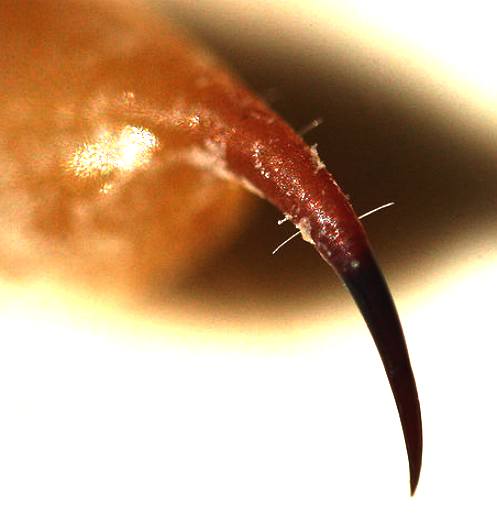
REPRODUCTION
Most scorpions reproduce sexually, and most species have male and female individuals. However, some species, such as Hottentotta hottentotta, Hottentotta caboverdensis, Liocheles australasiae, Tityus columbianus, Tityus metuendus, Tityus serrulatus, Tityus stigmurus, Tityus trivittatus, and Tityus urugayensis, reproduce through parthenogenesis, a process in which unfertilised eggs develop into living embryos. Parthenogenic reproduction starts following the scorpion's final moult to maturity and continues thereafter.
Sexual reproduction is accomplished by the transfer of a spermatophore from the male to the female; scorpions possess a complex courtship and mating ritual to effect this transfer. Mating starts with the male and female locating and identifying each other using a mixture of pheromones and vibrational communication. Once they have satisfied the other that they are of opposite sex and of the correct species, mating can commence.
The courtship starts with the male grasping the female's pedipalps with his own; the pair then perform a "dance" called the "promenade à deux". In this "dance," the male leads the female around searching for a suitable place to deposit his spermatophore. The courtship ritual can involve several other behaviours such as juddering and a cheliceral kiss, in which the male's chelicerae – pincers – grasp the female's in a smaller more intimate version of the male's grasping the female's pedipalps and in some cases injecting a small amount of his venom into her pedipalp or on the edge of her
cephalothorax, probably as a means of pacifying the female.
When the male has identified a suitable location, he deposits the spermatophore and then guides the female over it. This allows the spermatophore to enter her genital opercula, which triggers release of the sperm, thus fertilizing the female. The mating process can take from 1 to 25+ hours and depends on the ability of the male to find a suitable place to deposit his spermatophore. If mating goes on for too long, the female may eventually lose interest, breaking off the process.
Once the mating is complete, the male and female will separate. The male will generally retreat quickly, most likely to avoid being cannibalised by the female, although sexual cannibalism is infrequent with scorpions.
BIRTH
& DEVELOPMENT
Unlike the majority of species in the class arachnid, which are oviparous, scorpions seem to be universally viviparous. The young are born one by one after hatching and expelling the embryonic membrane, if any, and the brood is carried about on its mother's back until the young have undergone at least one molt. Before the first molt, scorplings cannot survive naturally without the mother, since they depend on her for protection and to regulate their moisture levels. Especially in species that display more advanced sociability (e.g. Pandinus spp.), the young/mother association can continue for an extended period of time. The size of the litter depends on the species and environmental factors, and can range from two to over a hundred scorplings. The average litter however, consists of around 8
scorplings.
The young generally resemble their parents. Growth is accomplished by periodic shedding of the exoskeleton (ecdysis). A scorpion's developmental progress is measured in instars (how many moults it has undergone). Scorpions typically require between five and seven moults to reach maturity.
Moulting commences with a split in the old exoskeleton just below the edge of the carapace (at the front of the prosoma). The scorpion then emerges from this split; the pedipalps and legs are first removed from the old exoskeleton, followed eventually by the metasoma. When it emerges, the scorpion's new exoskeleton is soft, making the scorpion highly vulnerable to attack. The scorpion must constantly stretch while the new exoskeleton hardens to ensure that it can move when the hardening is complete. The process of hardening is called sclerotization. The new exoskeleton does not fluoresce; as sclerotization occurs, the fluorescence gradually returns.
[edit]Relationship with humans
Scorpion sting and venom
All known scorpion species possess venom and use it primarily to kill or paralyze their prey so that it can be eaten; in general, it is fast-acting, allowing for effective prey capture. It is also used as a defense against predators. The venom is a mixture of compounds (neurotoxins, enzyme inhibitors, etc.) each not only causing a different effect, but possibly also targeting a specific animal. Each compound is made and stored in a pair of glandular sacs and is released in a quantity regulated by the scorpion itself. Of the 1000+ known species of scorpion, only 25 have venom that is deadly to humans; most of those belong to the family
Buthidae. However, all scorpions are able to penetrate human skin and deliver sharp, unpleasant stings, most of which usually leave redness around the stung area.
First aid
First aid for scorpion stings is generally symptomatic. It includes strong analgesia, either systemic (opiates or paracetamol) or locally applied (such as a cold compress). Hypertensive crises are treated with anxiolytics and
vasodilators.
Medical use
The key ingredient of the venom is a scorpion toxin protein.
Short chain scorpion toxins constitute the largest group of potassium (K+) channel blocking peptides; an important physiological role of the KCNA3 channel, also known as KV1.3, is to help maintain large electrical gradients for the sustained transport of ions such as Ca2+ that controls T lymphocyte (T cell) proliferation. Thus KV1.3 blockers could be potential immunosuppressants for the treatment of autoimmune disorders (such as rheumatoid arthritis, inflammatory bowel disease and multiple
sclerosis).
The venom of Uroplectes lineatus is clinically important in
dermatology.
Toxins being investigated include:
1. Chlorotoxin is a 36-amino acid peptide found in the venom of the deathstalker scorpion (Leiurus quinquestriatus) that blocks small-conductance chloride
channels. The fact that chlorotoxin binds preferentially to glioma cells has allowed the development of new methods, that still are under investigation, for the treatment and diagnosis of several types of
cancer.
2. Maurotoxin from the venom of the Tunisian Scorpio maurus palmatus
3. A number of antimicrobial peptides have also been found in the venom of Mesobuthus eupeus. Meucin-13 and Meucin-18 exhibited extensive cytolytic effects on bacteria, fungi and
yeasts.
Furthermore, Meucin-24 and Meucin-25, first identified from genetic sequences expressed in their venom gland, were shown to selectively kill Plasmodium falciparum and inhibit the development of Plasmodium berghei, both malaria parasites, but do not harm mammalian cells. These two venom-derived proteins are therefore attractive candidates for the development of anti-malarial
drugs.
Iranian researchers have also reported that the venom of M. eupeus has anti-inflammatory properties and is effective as an anti-arthritis treatment in an experimental species model, but the mechanism of action is
unknown.
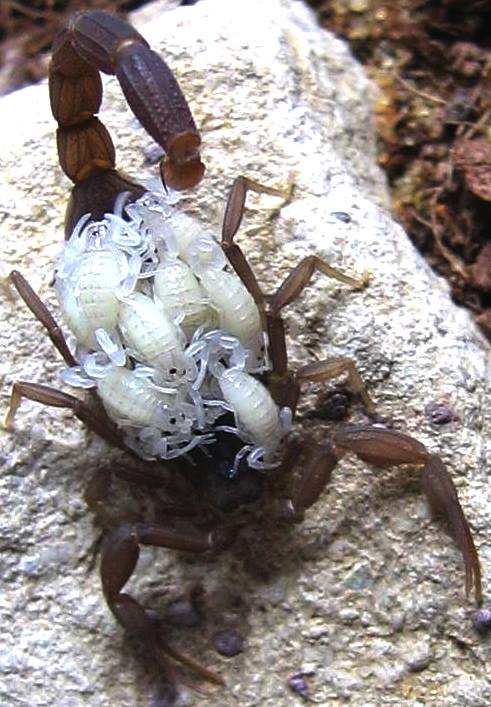
Scorpion
with her young
SCORPIONS
AS FOOD
Fried scorpion is a traditional dish from
Shandong, China.
As a part of Chinese medicine, scorpion wine and snake wine are used as analgesic and antidote.
SCORPIONS
IN CULTURE
One of earliest occurrences of the scorpion in culture is its inclusion, as Scorpio, in the twelve signs of the series of constellations known as the Zodiac by Babylonian astronomers during the Chaldean
period.
In North Africa and South Asia, the scorpion is a significant animal culturally, appearing as a motif in art, especially in Islamic art in the Middle East. It is perceived both as an embodiment of evil as well as a protective force that counters evil, such as a dervish's powers to combat
evil. In another context, the scorpion portrays human sexuality. Scorpions are used in folk medicine in South Asia especially in antidotes for scorpion
stings.
In ancient Egypt the goddess Serket was often depicted as a scorpion, one of several goddesses who protected the Pharaoh.
Surrealist filmmaker Luis Buñuel makes notable symbolic use of scorpions in his 1930 classic L'Age d'or (The Golden
Age).
The first two pages of Ian Fleming's novel Diamonds Are Forever are told from the point of view of an African scorpion that kills and eats a beetle and is then casually crushed and killed itself, by one of the villains whom James Bond would later confront and eventually
crush.
Survival expert Les Stroud finds and eats a live bark scorpion in the episode titled "Arizona Desert" of the documentary television series Survivorman.
Scorpions
glow blue at night
SCORPION
MARINE WEAPON SYSTEM
This
is human friendly weaponry developed for the autonomous
SolaNavigator vessel. Instead of blasting away indiscriminately,
this very cleaver weapon can target with such accuracy, that it
may avoid killing the crew of pirate
ships. Ironically, real scorpions use a two-tier strategy. The
first sting being a painful warning, the second being the death
injection:-
"Scorpions don't bother to waste venom killing a victim if they don't have to. Instead, they use a pre-venom that causes extreme pain, resorting to the deadlier version only when necessary, researchers discovered. A team led by entomologist Bruce D Hammock of the
University of California, Davis, was researching the possibility of an anti-venom for scorpions when they discovered the stinging creatures produced two kinds of venom. When first confronted by a threat, the scorpion produced a clear liquid on its stinger, Hammock said. The more deadly venom, a thick liquid, "like a milkshake," was produced later, if the threat continued. It's a clever strategy, Hammock explained, because the deadly true venom uses lots of proteins and peptides that are costly for the scorpion to make. Instead, it tries first to get by with a faster acting and more painful toxin that doesn't kill, but is easier to make.
The first scorpion weapon, what Hammock calls a pre-toxin, gets its kick largely from potassium salts that block receptors in animal cells, rapidly causing severe pain. "I was surprised," at the discovery of this pre-toxin, Hammock said. "We spent years looking at the very complex, highly toxic peptide toxin ...and the idea that the scorpion was using salt was a real surprise." It's of more than just biological interest that through evolution the scorpion has developed a way to generate pain and frighten predators and, if necessary, to follow this with a very highly toxic peptide
toxin, Bruce Hammock is quoted as saying."
Source:
The Star Ledger Tuesday 21 January 2003 from the Associated Press in Washington
SCORPION
HARD ROCK BAND
Scorpions are a German hard rock band formed in 1965 by
guitarist Rudolf Schenker, who is the band's only constant member (although Klaus Meine has been lead
singer for all their studio albums). They are known for their 1980s rock anthem "Rock You Like a Hurricane" and
many singles, such as "No One Like You", "Send Me an Angel", "Still Loving You", and "Wind of Change". The
band was ranked No. 46 on VH1's Greatest Artists of Hard Rock
program. "Rock You Like a Hurricane" is also No.
18 on VH1's list of the 100 Greatest Hard Rock Songs. On January 24, 2010, after 45 years of performing, the band
announced that they would be retiring after touring in
support of their new album Sting in the
Tail, although this decision was eventually retracted. The band has sold
over 100 million albums worldwide.
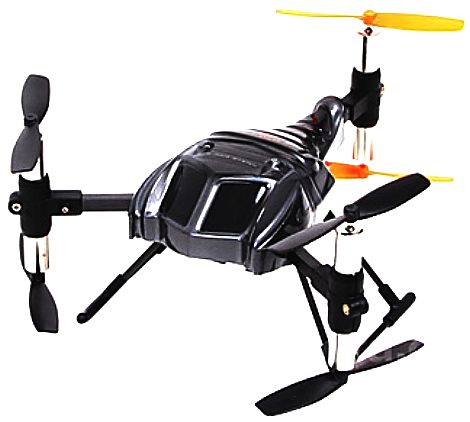
SCORPION
QR RADIO CONTROLLED HELICOPTER
A
remarkable innovation, a radio controlled six axis model
helicopter, the Scorpion QR and DEVO4 handset.

LINKS:
Scorpion
Facts for Researchers and Kids
Biolumunescence
in scorpions
Scorpion
anatomy
Scorpions
in Qatar
Caring
for a Pet Scorpion
Scorpion
detection using UV LEDs
"Scorpions
DesertUSA.com
Photogallery
– 36 species of scorpions
corpion
Venom Tested as Brain Cancer Treatment LiveScience
Beginner
species of exotic pets
Scorpions
– General information, care sheets, and more
Pet
Scorpion Information and facts | Scorpion Picture Guide
Scorpions
in Sayulita
Scorpions
from the Chihuahuan Desert Region of Mexico and the United
States
Illustrated
catalog of scorpions, Part I
http://books.google.com/?id=6OqeAAAAIAAJ
Scorpion
Scorpion
Dictionary.com.
http://flatrock.org.nz/topics/animals/scorpions_are_major_cause_of_death.htm
Skorpios
http://books.google.com/?id=6Yr_OJsU_aYC
The
Earthlife Web: The Scorpions
Official
Scorpion Band website
Photos
from concert Scorpions in Minsk 29.04.2010, Final World tour
Photos
from press-conference Scorpions in Minsk 29.04.2010
Scorpions
live photo gallery
Official
website "Big City Nights - The Scorpions Film",
documentary
Official
Scorpions profile on www.allmusic.com, article
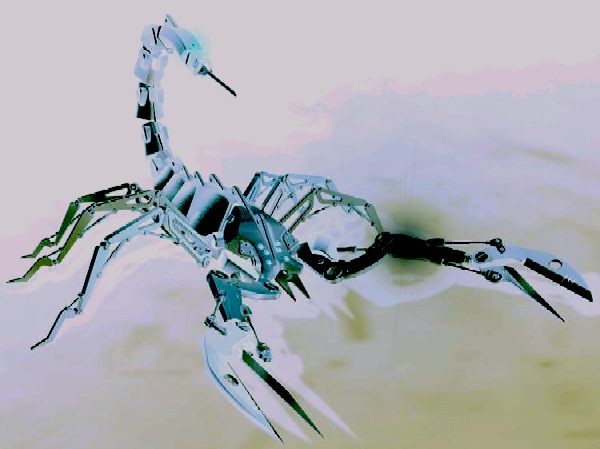
Please
use the Index below to navigate the Animal Kingdom:-

Global
warming has unexpected consequences for competing
groups of scientists
each
wanting to take credit for themselves
for the find of the century.
This
short story is being developed for
release as a full length novel
(e-book)
for
2015 with
storyboards for a film in
2016
of ASAP
thereafter.
|






